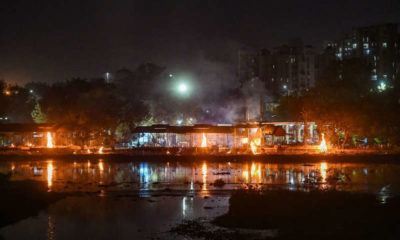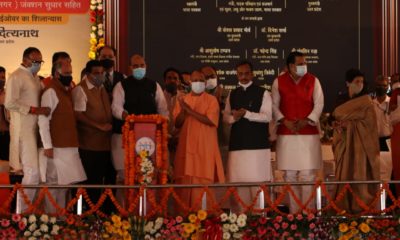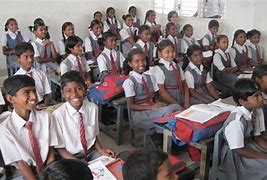Feature
DTC strike after driver’s murder hits Delhi, AAP warns agitators

New Delhi: Hundreds of thousands of commuters were hit hard on Monday as Delhi Transport Corporation (DTC) crews went on strike to protest against the killing of a driver by a biker in an incident of road rage. The AAP government threatened to take action, but the agitating staffers refused to budge.
Most of the DTC’s 4,705 buses went off the roads, with hundreds of drivers and conductors massing at the 45 depots spread across the city, shouting slogans.
A small fleet of buses which plied proved inadequate for the nearly 40 lakh people who use the DTC daily to commute, forcing them to largely turn to the already-crowded Delhi Metro.
In fact, the Delhi Metro Rail Corporation (DMRC) witnessed record ridership.
“The average ridership at 8 p.m. on Monday is 21 lakh, but today it was 22.92 lakh, an increase of 1.92 lakh,” a DMRC statement said.
The strike also affected DTC operations in the neighbouring states of Haryana and Uttar Pradesh.
Delhi’s Transport Minister Gopal Rai met officials to sort out the issue arising from Sunday’s incident when a biker, furious after being hit by a DTC bus, beat the driver to death.
Even as passengers watched, the biker repeatedly hit the 42-year-old driver, Ashok Kumar Singh, with his helmet and a small fire extinguisher installed in the bus. Singh bled to death while being taken to hospital.
As news of his death spread, DTC staff unions threatened a strike.
From Monday morning, drivers and conductors gathered at the depots and shouted slogans demanding strict action against the biker who has been arrested.
The worst affected were thousands of students whose schools hire DTC buses to ferry the children. With no buses, most students piled into auto-rickshaws and private vehicles to reach their schools.
By office time, hundreds of thousands of people made their way to Delhi Metro stations.
“Efforts are on to normalise the situation,” a transport ministry official told.
Delhi’s Aam Aadmi Party government threatened action against the agitating staffers who did not return to work, but to no effect.
“The government has taken a strict view of the completely unjustified and illegal strike by DTC employees. The government will deal sternly with the strike. Employees are advised to return to work immediately, failing which they will have to face serious repercussions,” it said.
However, the agitating drivers said they were “not sure” if they would return to work on Tuesday.
“The unions will discuss and take a decision soon,” Tara Chand, one of the agitating drivers, told IANS.
Chand is a member of the DTC Worker Unity Centre, which according to him is one of the four workers’ unions in DTC. At present, all four are on strike, he said.
The AAP government further blamed the Bharatiya Janata Party for not only politicising the issue but also for the strike.
“The compensation for the driver’s family has been announced and the guilty arrested. The BJP is behind the strike,” Rai told the media.
He said CCTV cameras would soon be installed in DTC buses and around 2,500 marshals deployed in the first phase.
The Delhi government also said it would bear the cost of education of the victim’s daughter.
Earlier, the BJP held a candle light march from Parliament Street to Jantar Mantar demanding justice for the deceased bus driver and asked the Delhi government to increase the compensation to Rs.1 crore. Delhi BJP chief Satish Upadhyay gave Rs.5 lakh to the driver’s family.
Upadhyay also met the agitating drivers at Rohini bus depot.
“They (AAP) promised to provide safety to women in Delhi especially in DTC buses. But even bus drivers are not safe,” he said.
Of the DTC’s 4,705 buses, 1,275 are air-conditioned and 2,506 non air-conditioned low floor buses. The rest are older standard buses.
“We managed to put 704 buses on the roads against all odds,” a DTC spokesman said.
A Delhi Metro official admitted to IANS that trains were crowded.
“Mondays are generally crowded but there is a lot of rush today because of the DTC strike,” the official said.
Entertainment
Meghalaya Reserves Legalized Gambling and Sports Betting for Tourists

The State Scores Extra High on Gaming-Friendly Industry Index
Meghalaya scored 92.85 out of 100 possible points in a Gaming Industry Index and proved to be India’s most gaming-friendly state following its recent profound legislation changes over the field allowing land-based and online gaming, including games of chance, under a licensing regime.
The index by the UK India Business Council (UKIBC) uses a scale of 0 to 100 to measure the level of legalisation on gambling and betting achieved by a state based on the scores over a set of seven different games – lottery, horse racing, betting on sports, poker, rummy, casino and fantasy sports
Starting from February last year, Meghalaya became the third state in India’s northeast to legalise gambling and betting after Sikkim and Nagaland. After consultations with the UKIBC, the state proceeded with the adoption of the Meghalaya Regulation of Gaming Act, 2021 and the nullification of the Meghalaya Prevention of Gambling Act, 1970. Subsequently in December, the Meghalaya Regulation of Gaming Rules, 2021 were notified and came into force.
All for the Tourists
The move to legalise and license various forms of offline and online betting and gambling in Meghalaya is aimed at boosting tourism and creating jobs, and altogether raising taxation revenues for the northeastern state. At the same time, the opportunities to bet and gamble legally will be reserved only for tourists and visitors.
“We came out with a Gaming Act and subsequently framed the Regulation of Gaming Rules, 2021. The government will accordingly issue licenses to operate games of skill and chance, both online and offline,” said James P. K. Sangma, Meghalaya State Law and Taxation Minister speaking in the capital city of Shillong. “But the legalized gambling and gaming will only be for tourists and not residents of Meghalaya,” he continued.
To be allowed to play, tourists and people visiting the state for work or business purposes will have to prove their non-resident status by presenting appropriate documents, in a process similar to a bank KYC (Know Your Customer) procedure.
Meghalaya Reaches Out to a Vast Market
With 140 millions of people in India estimated to bet regularly on sports, and a total of 370 million desi bettors around prominent sporting events, as per data from one of the latest reports by Esse N Videri, Meghalaya is set to reach out and take a piece of a vast market.
Estimates on the financial value of India’s sports betting market, combined across all types of offline channels and online sports and cricket predictions and betting platforms, speak about amounts between $130 and $150 billion (roughly between ₹9.7 and ₹11.5 lakh crore).
Andhra Pradesh, Telangana and Delhi are shown to deliver the highest number of bettors and Meghalaya can count on substantial tourists flow from their betting circles. The sports betting communities of Karnataka, Maharashtra, Uttar Pradesh and Haryana are also not to be underestimated.
Among the sports, cricket is most popular, registering 68 percent of the total bet count analyzed by Esse N Videri. Football takes second position with 11 percent of the bets, followed by betting on FIFA at 7 percent and on eCricket at 5 percent. The last position in the Top 5 of popular sports for betting in India is taken by tennis with 3 percent of the bet count.
Local Citizens will Still have Their Teer Betting
Meghalaya residents will still be permitted to participate in teer betting over arrow-shooting results. Teer is a traditional method of gambling, somewhat similar to a lottery draw, and held under the rules of the Meghalaya Regulation of the Game of Arrow Shooting and the Sale of Teer Tickets Act, 2018.
Teer includes bettors wagering on the number of arrows that reach the target which is placed about 50 meters away from a team of 20 archers positioned in a semicircle.
The archers shoot volleys of arrows at the target for ten minutes, and players place their bets choosing a number between 0 and 99 trying to guess the last two digits of the number of arrows that successfully pierce the target.
If, for example, the number of hits is 256, anyone who has bet on 56 wins an amount eight times bigger than their wager.























